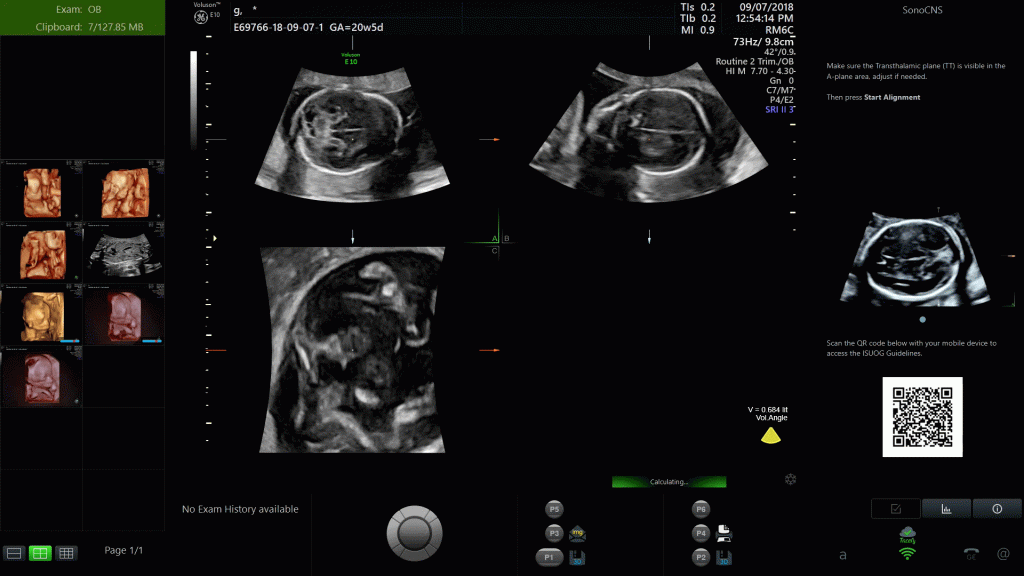
April 11, 2019

BABY MONITOR
Going in for their first ultrasound can be an anxious affair for expectant parents, but the process is no walk in the park for doctors, either. Measuring fetal brains, for example, is an imprecise science. One sonographer’s assessment could differ from another’s, possibly leading to missed or delayed diagnoses. All that is why Dr. Ralf Menkhaus, a longtime fetal medicine specialist in Minden, Germany, was happy to try GE Healthcare’s SonoCNS, which uses artificial intelligence to automate fetal brain assessment and measurement. The tool cuts the number of steps doctors must take while conducting ultrasounds, reduces guesswork and gives them more meaningful time with their patients, not to mention helping everyone involved breathe easier.
Pleased to meet you: A longtime devotee of Voluson E10 — the ultrasound system SonoCNS runs on — Menkhaus was asked by GE Healthcare to give feedback on how the new technology would change his workload. “It’s particularly beneficial for less experienced gynecologists,” said Menkhaus, who also trains medical professionals to use ultrasound systems. “Now, with the click of a button, they can have accurate and reliable measurements.” Such AI assistance can be lifesaving, but it also allows doctors like Menkhaus to slow the pace of ultrasound appointments, letting parents savor their first glimpse of the new life they’re preparing to welcome into the world.
Learn more here about how AI is making ultrasounds smarter and easier.
AI DONE RIGHT
When 1,700 of the world’s top healthcare leaders gathered in Boston this week for the World Medical Innovation Forum, GE Healthcare CEO Kieran Murphy was among them, discussing AI and his company’s ambitious work at the intersection of medicine and tech. But Murphy was also there to emphasize the need for a strong ethical code in this brave new AI world — an imperative his business has observed by being one of the first healthcare companies to adopt ethical guidelines for the use of AI technology. They include requirements for trustworthy data stewardship, transparency in delivering results and vigilance against bias, among other things. “We’re very careful to ensure that this is done in the right way,” Murphy said in an interview with LinkedIn’s newsletter The Checkup. “People have a natural suspicion of AI.” In his own LinkedIn post, Murphy chatted about the topic with Dr. James Brink, radiologist in chief at Massachusetts General Hospital and a keen thinker on the future of medicine.
Power in numbers: Done right, AI can be enormously beneficial — as in a new application being developed by GE Healthcare and Partners HealthCare with a single, crucial goal: better stroke detection. Time is paramount in detecting and treating strokes, which befall someone in the U.S. every 40 seconds. The app in development has the potential to act fast because it relies on insights from an algorithm that’s crunched data from 1 million images and 22,000 patient studies and will be validated by seven healthcare institutions around the world. “An algorithm will be better at detecting stroke if it sees 1 million examples versus 100,” said Keith Bigelow, senior vice president of Edison Portfolio Strategy at GE Healthcare.
Bigelow thinks successful AI development in healthcare is both a science and an art. Learn more about that, and more on stroke-detecting algorithms, here.
BLACK HOLE IN THE SPOTLIGHT
Black holes are so astonishingly dense that not even light can escape from them — but it turns out they’re not so reclusive that they can’t get their picture taken. A worldwide collaboration of 200 researchers has yielded the first-ever image of a black hole, a snapshot of an object at the center of the galaxy Messier 87, some 55 million light-years away. Astronomer Shep Doeleman told the New York Times, “We have seen what we thought was unseeable.” And unthinkable, too, until Albert Einstein predicted the existence of objects so dense that they warp the fabric of space-time; the photo session lends yet more credence to his theory of general relativity. Times science writer Dennis Overbye added: “The image offered a final, ringing affirmation of an idea so disturbing that even Einstein, from whose equations black holes emerged, was loath to accept it.” The picture is far from the last word on the subject, though.
Eyes on the skies: Since 2004, three satellites have been launched to study gamma ray bursts — mysterious galactic flashes of intense radiation that, according to one theory, may come from black holes as they consume large stars. (Like a burp, to use an earthier analogy.) The most recent, Astrosat, carried a sensor made by GE Healthcare that uses a compound of cadmium, zinc and telluride (CZT) to detect radiation. Painstaking to produce, CZT sensors are sensitive to radiation from the farthest reaches of the cosmos to the tiniest parts of the body. Scientists at GE Healthcare developed them to allow doctors to use smaller doses of radiation while achieving fantastic resolution and clarity, aiding them in tracking down disease in the human body.
A planned new satellite will use CZT sensors to continue to home in on the source of gamma ray bursts, shedding light on the very formation of the universe in the process. Learn more here.
— VIDEO OF THE WEEK —

— QUOTE OF THE DAY —
“With these tools come remarkable new capabilities, leveraging the power of big data as applied to human health and disease.”
— James Brink, radiologist in chief at Massachusetts General Hospital
Quote: GE Reports. Image: GE Healthcare.
ENJOY THIS NEWSLETTER?
Please send it to your friends and let them know they can subscribe here.




